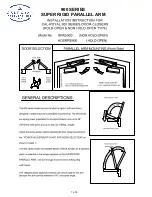
23
Smart Pro
installation instructions
22. After Installation Care
When batteries reach the end of their usual life in accordance with Australian Battery Recycling Initiative please
follow the next simple steps for protecting the environment. Refer to the Automatic Technology website for information
on where to recycle batteries in Australia.
DO NOT throw the batteries in municipal waste. This symbol of the crossed out wheeled bin
indicates that the battery should not be placed in the municipal waste. Check your local
regulations for appropriate disposal of the batteries.
Recycling all batteries will have other environmental and social benefits:
WARNING! Prior to disposal, recycling, or collection, all battery terminals must be securely
insulated with a non conductive material to prevent any two batteries from short circuiting and
generating heat during storage or transport. Battery terminals may be insulated with electrical
tape; or batteries may be individually packaged in a non conductive material
(e.g., plastic bag or original packaging).
22.3 Battery Disposal
Battery Type:
3V Lithium Battery CR2032.
a. To test the battery is working, press and hold a
transmitter button. Check Light Status table to
determine if battery needs replacing
Light Status
Battery Status
Solid
OK
Flashing
Requires replacement
No light
Requires replacement
22.2 Battery Replacement
Use a pen
to push the
battery down
through the
side opening
to release
battery
b. Use a screwdriver to remove the screw on the back of
the transmitter casing.
c. Use the screwdriver to pry open the plastic to expose
circuit board.
d. With a non-metallic object (e.g. pen) remove the
battery.
•
Some batteries are less toxic but hazardous for other
reasons. Lithium batteries can explode or catch fire in landfill,
while button cells are dangerous if swallowed by children.
Recycling offers a safe and environmentally responsible
solution for end of life batteries.
•
Battery recycling recovers non-renewable materials such
as lead, cadmium, stella, zinc, manganese, cobalt, silver,
plastics and rare earth elements.
•
Removal of batteries and other hazardous household
products from household waste facilitates the recovery of
organic materials through alternative waste technologies
such as composting. Batteries and heavy metals are known
contaminants in compost.
•
The community supports recycling because it reduces
waste to landfill and achieves environmental benefits.
Warranty conditional on proper servicing as listed in 22.1 Service Checklist. Full details of the warranty are available
in your Owners Opener Handbook, from your nearest B&D office or visit the B&D Website
22.4 Warranty
WARNING! Chemical Burn Hazard. Keep
batteries away from children
WARNING! The Battery shall be disposed of properly, including keeping them away from children.
Even used batteries may cause injury.






































